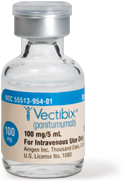INDICATION AND LIMITATION OF USE
Vectibix® is indicated for the treatment of patients with wild-type RAS (defined as wild-type in both KRAS and NRAS as determined by an FDA-approved test for this use) metastatic colorectal cancer (mCRC):Read More
Vectibix® is indicated for the treatment of patients with wild-type RAS (defined as wild-type in both KRAS and NRAS as determined by an FDA-approved test for this use) metastatic colorectal cancer (mCRC):Read More
*Correlation with efficacy or safety is unknown.
EGFR = epidermal growth factor receptor.

Recommended dose is 6 mg/kg every 14 days.1

No standardized premedication was required in clinical trials. The utility of premedication in preventing infusional toxicity is unknown.1

No loading dose is required.1
Vectibix® may be given during the same visit as chemotherapy.1
Initial Dose

Vectibix® is given by IV infusion over 60 minutes.1
Subsequent Doses

If the first infusion is tolerated, subsequent infusions may be administered over 30 to 60 minutes.1

Vectibix® should be administered over 90 minutes.1
Prepare the solution for infusion using aseptic technique, as follows:

Parenteral drug products should be inspected visually prior to administration. The solution should be colorless and may contain a small amount of visible translucent-to-white, amorphous, proteinaceous particles (which will be removed by in-line filtration).1
Use a 21-gauge or larger (small-bore) hypodermic needle to withdraw the necessary amount of Vectibix® for a dose of 6 mg/kg.1

Doses ≤ 1,000 mg: Dilute to a total volume of 100 mL with 0.9% sodium chloride injection, USP.1
Doses > 1,000 mg: Dilute to a total volume of 150 mL with 0.9% sodium chloride injection, USP.1

Mix diluted solution by gentle inversion.1
Vectibix® must be administered via an infusion pump using a low-protein-binding 0.2 μm or 0.22 μm in-line filter1

Do not administer Vectibix® as an intravenous push or bolus.1

Flush line before and after Vectibix® administration with 0.9% sodium chloride injection, USP, to avoid mixing with other drug products or intravenous solutions.1

Doses ≤ 1,000 mg: Infuse over 60 minutes through a peripheral intravenous line or indwelling intravenous catheter.1
Doses > 1,000 mg: Administer over 90 minutes.1

Use the diluted infusion solution of Vectibix® within 6 hours of preparation if stored at room temperature or within 24 hours of dilution if stored at 2° to 8°C (36° to 46°F). DO NOT FREEZE.1
| Example dose calculation1 | 400 mg | 100 mg | |
|---|---|---|---|
| Patient weight | 76 kg |  (20 mL vial size) |
 (5 mL vial size) |
| Dose | 6 mg/kg | ||
| Dose calculation | 6 mg/kg x 76 kg = 456 mg (22.8 mL) |
||

DOSE MODIFICATIONS FOR INFUSION REACTIONS
Dermatologic Toxicity: Dermatologic toxicities occurred in 90% of patients and were severe (NCI-CTC grade 3 and higher) in 15% of patients receiving Vectibix® monotherapy [see Dosage and Administration (2.3), Warnings and Precautions (5.1), and Adverse Reactions (6.1)].
Please see Vectibix® full Prescribing Information, including Boxed WARNING.
Vectibix® is indicated for the treatment of patients with wild-type RAS (defined as wild-type in both KRAS and NRAS as determined by an FDA-approved test for this use) metastatic colorectal cancer (mCRC):
Vectibix® is not indicated for the treatment of patients with RAS-mutant mCRC or for whom RAS mutation status is unknown.
Dermatologic Toxicity: Dermatologic toxicities occurred in 90% of patients and were severe (NCI-CTC grade 3 and higher) in 15% of patients receiving Vectibix® monotherapy [see Dosage and Administration (2.3), Warnings and Precautions (5.1), and Adverse Reactions (6.1)].
Reference 1. Vectibix® (panitumumab) prescribing information, Amgen.